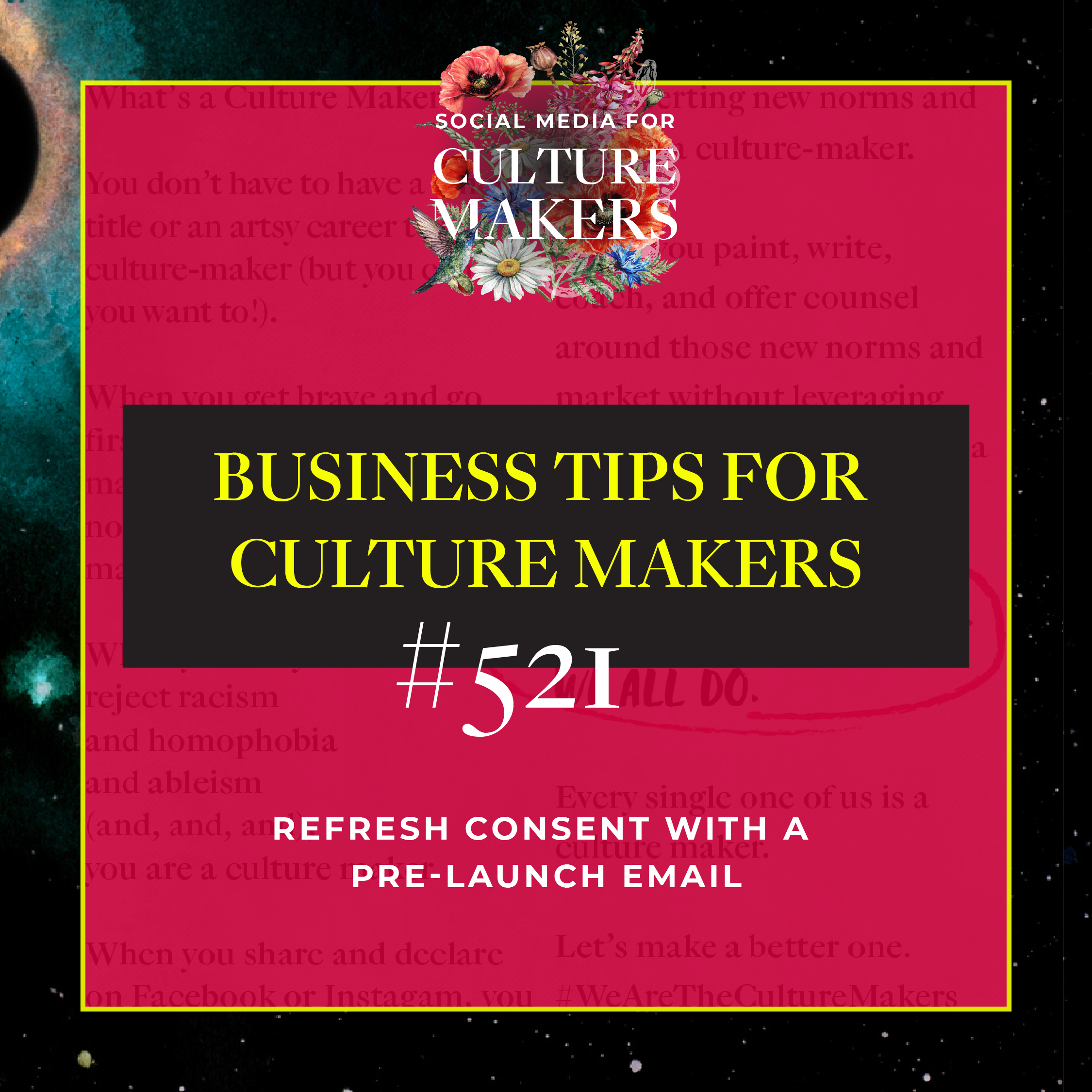
Business Tip for Culture Makers #521: Refresh Consent with a Pre-Launch Email
Sending a pre-launch email seeking to refresh consent is a culture-making move. It reinforces the culture-making principle that consent is sacred; and practicing consent in all things helps us chip away at the foundation of rape culture. And, contrary to the narrative that says anti-oppressive principles are bad for business, refreshing consent also can be good for sales. Refreshing consent preserves your list, builds trust with your audience, and can even increase your sales. True Story.
In this Culture Making Marketing Tool, you’ll learn how to implement The Refresh Consent Pre-Launch Process in your email marketing (and your culture-making!).
This Culture-Making Marketing Tool contains:
1. CONTEXT. The Politics of Consent in Our Email Marketing Practices — and Why It Matters
2. PRACTICE. What Renewing Consent for Sales Emails Looks Like in Practice
3. HOW-TO. The Step-by-Step Guide for Creating The Prelaunch Refresh Consent Process*
4(a) FOLLOW UP. How to Continually Renew Consent after You Run The Refresh Consent Pre-Launch Process
4(b) SWIPE COPY. Swipe Copy for Refreshing Consent
5. OUTCOME. The Culture-Making, Business-Building Impact of Refreshing Consent
6. CULTURE MAKING. Refreshing Consent is a Culture-Making Move…That Boosts Your Marketing Confidence (and Can Increase Sales!)
7. OPTION FOR MAILCHIMP Op-out of Specific Campaigns
8. MORE RESOURCES re: Consent + Online Marketing and Culture-Making Marketing/Business Practices
9. DOWNLOAD. Get the Downloadable, Shareable Guide complete with examples and swipe copy
1. CONTEXT. The Politics of Consent in Our Email Marketing Practices — and Why It Matters
As a survivor and a HUMAN WITH A CONSCIENCE, I cherish consent. I want to live in a world where consent is a foundational practice. #endrapeculture
I’m also a content marketer and a marketing consultant. I took all.the.courses; got properly trained up; and now I have more than a decade of experience crafting campaigns and running launches.
So I know from intimate, first-hand professional experience that MANY of our standard online marketing tactics — the ones everyone uses, the ones that are standard in all the courses, the ones we take for granted as the norm — over-ride or devalue consent.
(I’ve written about this, A LOT — check out my list of resources at the end of this post.)
Here’s the problem with that: when we use these tactics, whole, then we are co-authoring a culture where it is NORMAL and routine to devalue consent.
Our current cultural and marketing norms are the norms of the rape culture we live in: do whatever it takes to get what you want (sex, a sale), even if it’s not in the best interests of the other person nor what they want.
In the culture I’m dreaming of, the norm will be : let’s get enthusiastic consent to do something that’s great for both of us (sex, a sale).
We can call that culture into being by living into it with our daily practices — including our culture-making marketing and business practices.
And we all know by now that consent is not one-and-done. Circumstances change. People change their minds. The vibe changes — and we need to shift with it. Consent needs to be continually renewed and reaffirmed in our interactions with each other.
Including in our email marketing.
2. What Renewing Consent for Sales Emails Looks Like in Practice
Let’s use my biz and list as an example:
- Some of the people who are subscribed to my email newsletter (#SundayLoveLetterByKellyDiels) have been on my list for TEN YEARS — so what they wanted when they signed up may not be what they want from me, now…nor even what I’m serving up
- Some of the people on my list want my critique and cultural commentary
- Some of the people on my list want my business and marketing tools
- Some of the people are women trying to get out of shame and into power. They’re here for all my power-building, career-growing, self-authoring strategies and re-frames but don’t want to hear about my marketing services or tools
- Some people signed up for the weekly newsletter but do not want to get the mailers (the sales emails)
Side note: There’s a difference between an email newsletter and a sales email (“mailer”)
So before I initiate a new email marketing campaign that’s usually only relevant to one of those groups, I send a pre-launch “consent refresh” email.
- In that email, I let readers know that I’m going to be promoting something over the next days/weeks/monthsand explicitly ask them if they want to hear about it
- If they do NOT want to get those emails, I give them an opt-out link to click
IMPORTANT: this is different than clicking the universal unsubscribe link that’s embedded in all our newsletter, because the reader is choosing to stay subscribed. They will still get the newsletter. They just won’t get the sales mailers on this topic
- They land on a thank you page confirming their choice and reminding them that although they are not going to get the mailers on this topic, they will continue to get my Sunday Love Letter
- In the backend of my list software, if they click that link, they automatically get tagged and added to a segment
- All future emails I send on that topic do NOT get sent to that segment (you have to define that in the user groups you select to send the communication to — and DO NOT FORGET TO DO THIS)
3. The Step-by-Step Guide for Creating The Prelaunch Refresh Consent Process*
*This formula is based on the process in Convertkit, but you can do this in other providers, too, and you can probably find a tutorial from your provider showing you how to do this by googling using keywords like these ones:
[your provider name] + manage subscriber preferences
[your provider name] + refresh consent
[your provider name] + renew permission
[your provider name] + list hygiene
[your provider name] + permission reminder
- PAGE. Create an opt-out page on your website (hide it from search engines)
- TAG. In your list/email provider, create a subscriber tag
- SEGMENT. In your list/email provider, create a segment based on subscribers with that tag applied
- RULE/AUTOMATION. In your list/email provider,Create a “Rule” that says anytime anyone gets tagged with that tag, they get added to that segment
- DRAFT EMAIL. In your list/email provider, write your Refresh Consent Email
- EMAIL COPY. In that email, give people the option to opt-out of this campaign, but remain on your overall list
- Ask them to click a link if they want to opt out (that link will go to the opt-out page on your website)
- Clicking that link will trigger the rule/automation you just built to run in the background; these folks will get added to your opt-out segment
- FILTER. In your next marketing emails, make sure to create a filter that says do not include the subscribers in that segment
Voila! You just ran The Refresh Consent Pre-launch Process.
4(a) How to Continually Renew Consent after You Run The Refresh Consent Pre-Launch Process
Obviously, not everyone is going to open or read that one email.
So if you want to get more coverage for this message, you can repeat the refresh-consent process in your sales emails. Here’s a screen grab from a recent email I sent:

4(b) Swipe Copy for Refreshing Consent
If you want to use that line of copy as swipe copy, feel free! Here it is:
As always, if you DO NOT want to receive any more emails about _______, you can opt out by clicking here, <insert link>. You’ll still receive my ________ every ______ — and thank you!
5. The Culture-Making, Business-Building Impact of Refreshing Consent
There’s this narrative out there telling us that changing our business practices to produce a social good is bad for business. This narrative makes us fear our own principles and fear the consequences of building them into our marketing strategies and our business practices..
We hear it explicitly, regularly, in conversations about how executives “don’t want to lower standards” to hire for diversity. There’s obviously a racist/sexist assumption in that formula AND there’s a conclusion that not being an asshole is bad for business.
And so a lot of the time, there’s a subconscious, half-articulated fear in the back of our heads — especially if we’re running under-capitalized start-ups and bootstrapping our business growth out of cash flow, hope and grit — that if we use equitable business practices, and we do NOT use The Usual Non-Consent-Based Tactics, then we’re not going to make the sales.
I want to assure you, from my experience in my own business, and from being a coach and consultant to hundreds of organizations and solopreneurs, that YES WE CAN achieve our sales and revenue targets when we do business on our terms — based on our principles, using culture-making business practices.
6. Refreshing Consent is a Culture-Making Move…That Boosts Your Marketing Confidence (and Can Increase Sales!)
Part of it is about confidence/alignment
When I feel good about my marketing, because it’s grounded in consent and culture-making principles, then I market fluidly, with enthusiasm, and OFTEN. The result: way more sales. (Consistency is an entrepreneur’s best friend.)
When I use status-quo marketing that over-rides consent, however, I feel ashamed of my marketing, worried that people think it’s sleazy, and then I don’t post or send or advocate for my own work. Because the marketing doesn’t align with my values.
Marketing WITH your culture-making principles, instead of against them, is a power move that’s actually good for business.
Part of is TRUST and Leadership and CULTURE MAKING
When I send these Refresh Consent pre-launch emails, I get an amazing response.
- People email me to thank me for practicing what I preach
- People email me to ask me the process for doing this, so they can do it in their business, too (that’s why I wrote this up!)
- People click through to my website and buy things I wasn’t even trying to promote — and then email me to say that the Refresh Consent was what sealed the deal for them. They saw my commitment-in-action to consent, and thought, yes this is the business teacher I want to learn from.
- People forward the email to groups and networks and discuss it!
In those Refresh Consent Pre-launch emails, I’m not even pitching! And I still make sales. Honestly, the first couple of times I did this, I didn’t know that would happen. It was a happy accident. I’m telling you this does consistently happen, though, to reassure you that you CAN do business based on your principles, using culture-making practices, and still flourish, financially.
Most recently, I sent The Pre-launch Consent Refresh Email and ended up making 1/3 of my stretch goal before even launching the campaign. This is big, because in my experience most launches bring in 90% of their revenue in the last 24 hours. I hadn’t even started launching and was already 30% of the way to my stretch goal!
So…attending to consent when you have an audience who cherishes consent will not degrade your sales. It might even increase them, without you having to grind it out. #antihustle #emergentstrategy
AND: when you do things like this, it has a culture-making impact. Other business leaders and culture-making entrepreneurs decide to do it too.
And that’s how we start establishing a new business norm and a new cultural norm. We start chipping away at the foundations of rape culture. When we practice consent in all things — including our marketing — then we’re asserting that consent is non-negotiable, sacred, and belongs everywhere.
In our businesses, our inboxes and our lives. #WeAreTheCultureMakers
7. MODIFICATION: How to Use Mailchimp to Run a Refresh Consent Campaign
Special thanks to Emiko Jaffe (https://www.phases-fitness.com/about) and Chrissy Marquardt (https://iamchrissy.com/) for adapting this process!
Here’s how to do this process using MailChimp
- Create a tag like “No Promo” –– adding a date to the tag or other specifiers for a campaign you plan on running multiple times will allow you to re-run the consent email, giving subscribers who may have opted-out the opportunity to opt-in in the future if they choose to.
- Create a segment like “Yes Promo”–adding a date to the tag or other specifiers in order to run the campaign in the future and the date around how many/who opts-out once and opts-in later may be helpful.
- For the first parameter: choose “Email marketing” + “is” + “Subscribed” to include everyone on your list.
- Second parameter: choose “Tags” + “contact is not tagged” + “No Promo” to include everyone on your except for those who have opted-out from your survey–everyone under “No Promo” will be excluded.
- Example:
- Create a Survey. Create one radio button titled something like “Opt-out of promo” and assign it with the tag “No Promo.” When a subscriber clicks this button, they will be assigned to the “No Promo” tag. In the asking for consent email sent out to the list, you can then link the survey.
- Use your audience under “Yes Promo” to send out promotional campaigns to those who choose to subscribe.
Notes:
- Here’s a video on how to create a segment that excludes a specific tag.
- Consider including a message at the end of every promotional email, allowing people in the “Yes Promo” segment to opt-out of promotional emails while still receiving your newsletter. Simply link the survey (created in step 4) to the message. Since Mailchimp subscribers can either subscribe or unsubscribe to the email list and there is no option to opt-out of a specific campaign, you may want to do this. This allows subscribers to choose to remain on your email-list without seeing promotional emails.
- Tags and segments will update in real-time as subscribers choose to opt-out.
8. Related Resources about Consent + Online Marketing, and Culture-Making Marketing Practices
Essays and Business Tools for Culture-Makers From Me:
- Content Marketers are (Inadvertent) Culture Makers — So Let’s Make It Count by Kelly Diels— Sometimes, as marketers and humans, we’re accidentally complicit in reinforcing the very norms we want to oppose. Let’s get deliberate and create the business and culture outcomes we are dreaming of and INTENDING
- on the abuse of reciprocity and women by Kelly Diels— How the common online marketing tactic (called a “social trigger” or a “mental trigger”) called reciprocity replicates and reinforces rape culture
- On the ‘Mental Triggers’ of Online Marketing, The Female Lifestyle Empowerment Brand, Assessing Who Deserves Your Money, and Why We Should Be Skeptical of Makeover Stories by Kelly Diels — The status quo online marketing formulas we learn everywhere — including from other, seemingly ’empowered’ women — reinforce oppression. Let’s get tactical and do it differently, using feminist marketing practices
- Business Tip for Culture Makers #529: Nope, Opt-Ins are NOT Mandatory by Kelly Diels — Rethinking the politics of lead magnets
- Business Tips for Culture Makers by Kelly Diels– My library of equitable, responsible, consent-based marketing tactics
Leaders Working at the Intersection of Business/Liberation/Anti-Oppression:
- Everything Toi Smith teaches about liberatory business and marketing practices is BRILLIANT
- Bear Hebert is doing beautiful work on anti-oppressive business and livelihood
Books at The Intersection of Culture-Making/Business-Building/Org-Development
- Feminism: A Key Idea for Business and Society by CV Harquail
- It’s About Damn Time by Arlan Hamilton, founder of Backstage Capital
- Think Like a SheEO by Vicki Saunders, founder of SheEO
- Emergent Strategy by adrienne maree brown
9. Get this Guide as a Downloadable PDF!
Want more Business Tips for Culture Makers to help you build your business? Check out the library of Culture Making Marketing Tools, here




